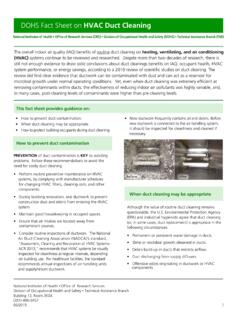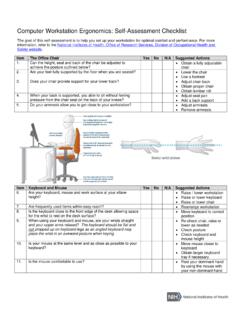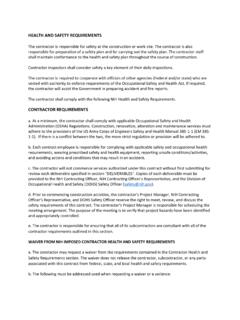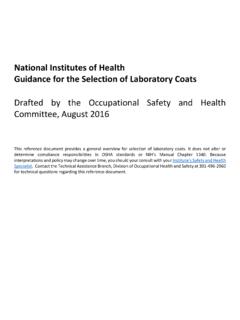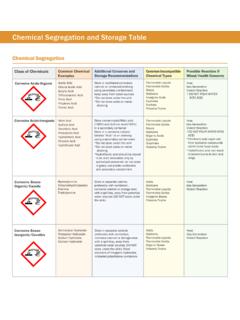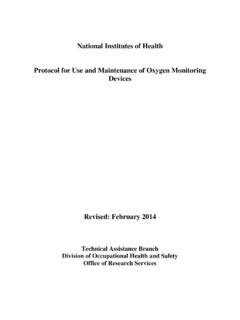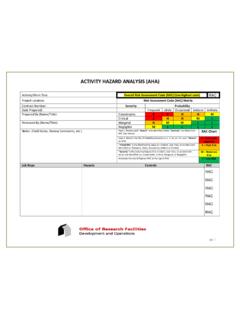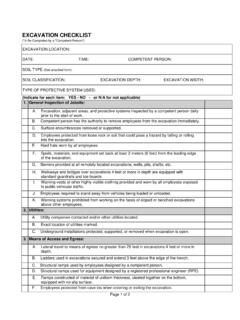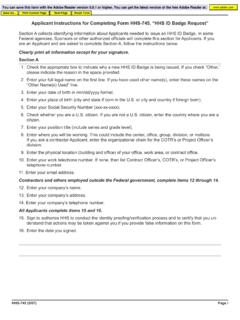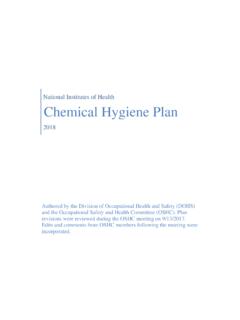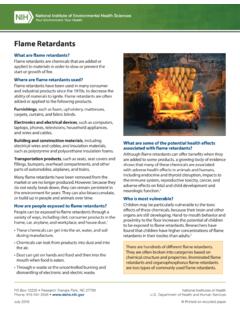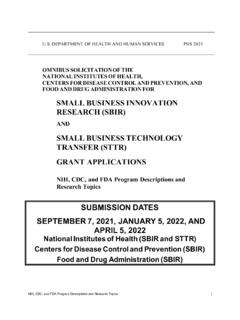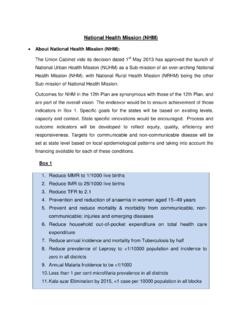Transcription of Hazard Communication Program - National Institutes of …
1 NIH Division of Occupational health and Safety Hazard Communication Program 2018 Authored by the Division of Occupational health and Safety (DOHS) Hazard Communication Program (HCP) Manager. NIH Division of Occupational health and Safety | Significant Content Changes since Prior Version: 1. Added Scope clarifying groups not involved in the HCP. 2. Removed wording Non-Laboratory as this has been clarified in the Scope. 3. Clarification of responsibilities. 4. Added 29 CFR language to include routine and foreseeable emergencies. 5. Defined groups which would not be covered by HCP but under other regulations (FDA, Chemical Hygiene Plan, and exempt). 6. Clarification in training: DOHS performs the formal training and supervisor performs the on the job training.
2 7. Added section for contractors who may be brining hazardous chemicals onto campus and referred to Contractor Safety Program for additional needs. 8. Sections exempting warehouse storage have been removed as storage of chemical containers does fall under the standard. Editorial/Minor Changes: 1. Grammar/spelling/punctuation as needed. 2. Format changes, including standardized cover page per DOHS request and amended contents section. 3. Fixed margins, headers, and footers. 4. Reduced redundant statements and rewording for overall clarity. 5. Removed incorrect use of around words. NIH Division of Occupational health and Safety | CONTENTS 1 I. THE NIH Hazard Communication Program (NIH HCP).. 2 A. Policy 2 II. 3 A. Responsibilities for the Director, 3 B. Responsibilities of the 4 C.
3 Responsibilities of the Principal Investigator and Laboratory 4 D. Responsibilities of the E. Responsibilities of the Division of Occupational health and Safety (DOHS).. 4 F. Responsibilities of the NIH Occupational Safety and health 5 III. THE NIH HCP 5 A. Identification of Hazardous 6 B. Maintenance of Current Hazard Information at 6 i. 7 ii. Safety Data Sheet (SDS).. 8 C. Employee Information and 10 i. Hazardous Non-Routine 10 ii. Informing Contractor and Contract iii. Contractor and Contracted Workers Informing NIH of Hazardous Chemicals Being 11 iv. Program 11 IV. GUIDANCE IN IMPLEMENTING THE NIH 11 A. Checklist for Implementing the NIH ..11 V. ANSWERS TO QUESTIONS ON Program 12 APPENDIX A General 17 APPENDIX B National Library of Medicine (NLM) Databases for Chemical Hazard 18 APPENDIX C NIH HCP 19 APPENDIX D Glossary of 20 APPENDIX E Activity Hazard Analysis 23 ACRONYMS ACGIH American Conference of Governmental Industrial Hygienists CFR Code of Federal Regulations CHP Chemical Hygiene Plan (DASHO)
4 Designated Safety and health Official DEP Division of Environmental Protection DOHS Division of Occupational health and Safety GHS Globally Harmonized System of Classification and Labeling of Chemicals HCP Hazard Communication Program IC Institutes and Centers NIOSH National institute of Occupational Safety and health NIH National Institutes of health NLM National Library of Medicine OMS Occupational Medical services ORS Office of Research services OSHA Occupational Safety and health Administration OSHC Occupational Safety and health Committee PEL Permissible Exposure Limit PI Principal Investigator PPE Personal Protective Equipment SDS Safety Data Sheet TLV Threshold Limit Value published by ACGIH NIH Division of Occupational health and Safety | January 2018 | 1 INTRODUCTION The National Institutes of health (NIH) is committed to providing a safe and healthy work environment.
5 The purpose of the NIH Hazard Communication Program (NIH HCP) is to increase employee awareness of hazardous chemicals used in the workplace so that they can recognize known and potential hazards and take proactive measures to minimize harm to themselves, others, and the environment. The comprehensive approach outlined in the NIH HCP will reduce employee exposure to potential chemical hazards. Potential chemical hazards consists of two main categories: chemical hazards during normal conditions and foreseeable emergencies. Additionally, the HCP improves the quality and consistency of Hazard information in the workplace: making it safer for workers by providing easily understandable information on appropriate handling and safe use of hazardous chemicals. The ultimate goal of these efforts is to empower the individual worker with knowledge and skills so that they can take measures independently of the NIH policies to protect themselves, coworkers and the environment.
6 The NIH HCP complies with the Occupational Safety and health Administration (OSHA) Hazard Communication Standard, 29 CFR Success of the Program depends on the joint efforts of administration, managers and supervisors, Division of Occupational health and Safety (DOHS), and NIH employees. The NIH HCP has been established to provide information to employees about chemical hazards. This information is communicated in three primary ways: 1. Safety data sheets (SDSs); 2. Warning labels and signs; and 3. Training employees on chemical hazards in the workplace. The first sections of the NIH HCP describes the responsibilities that NIH management, supervisors, and employees have in developing, implementing, and maintaining the NIH HCP. It also describes how each of these Communication methods listed above is used to inform employees on the hazardous properties of the chemicals in their workplace and to safely handle, store, and use those agents.
7 The ending sections includes a summary of the NIH HCP, along with a checklist of how to implement the Program . NIH Division of Occupational health and Safety | January 2018 | 2 I. THE NIH Hazard Communication Program (NIH HCP) A. Policy Statement It is the policy of NIH that all employees who potentially are exposed or knowingly handle hazardous chemicals in their assigned jobs shall be fully informed of both the hazardous properties of the chemicals, and the protective measures available to minimize adverse exposure to these chemicals. This information is made available to employees by means of: labels on chemical containers, SDSs, and training. Employees will be informed of any known hazards associated with chemicals to which they may be potentially exposed before their initial assignment and whenever the hazards change.
8 B. Scope The NIH HCP provides the mandatory requirements for safe use of hazardous chemicals. The HCP effects all employees with the exception of employees working in research laboratories; employees using food, food additives, color additives, drugs, cosmetics, or medical or veterinary devices or products; and administrative employees whose use of hazardous chemicals only in non-routine/isolated instances. Research laboratories are defined as facilities where hazardous substances are designed to be easily and safely transferred and manipulated by one person and are used on a non-production basis. Employees who work in a research laboratory will follow the NIH Chemical Hygiene Program . Employees who use food, food additives, color additives, drugs, cosmetics, pesticides, or medical or veterinary devices or products are required to follow the FDA 21 301 regulations.
9 Administrative employees who do not routinely encounter hazardous chemicals are not at risk for occupational exposure to hazardous chemicals and are not covered by the NIH HCP. All supervisors in effected areas must determine which chemicals may present a Hazard to their employees based on the physical and chemical properties of the substance; potential health effects; and how the substance is used. The supervisor shall create and maintain a hazardous chemical inventory including chemicals in active use and storage for their areas of responsibilities. For assistance in determining which Program or policy covers your work activities, please contact DOHS for assistance. II. RESPONSIBILITIES Effective Hazard Communication can be accomplished when responsible management and responsive employees work together in developing and implementing an integrated Hazard Communication Program .
10 The NIH HCP is performance-based, allowing for flexibility in implementing the Program components depending on the needs of the employees within the various work environments. The roles and responsibilities of NIH management and employees are outlined below. NIH Division of Occupational health and Safety | January 2018 | 3 A. Responsibilities of the Director, NIH The Director, NIH, is ultimately responsible for the health and safety of all NIH employees. The Director has delegated the authority to manage and administer the occupational safety and health programs to the Designated Safety and health Official (DASHO), which is the Director of the Officer of Research services (ORS). The ORS Division of Occupational health and Safety (DOHS) develops and implements the HCP. The Division of Occupational health and Safety is responsible for development and implementation of the HCP.
